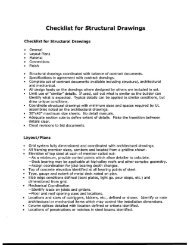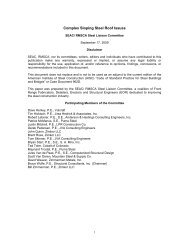Architecturally Exposed Structural Steel - Arquitectura en acero
Architecturally Exposed Structural Steel - Arquitectura en acero
Architecturally Exposed Structural Steel - Arquitectura en acero
You also want an ePaper? Increase the reach of your titles
YUMPU automatically turns print PDFs into web optimized ePapers that Google loves.
Interior <strong>en</strong>vironm<strong>en</strong>t, low-<strong>en</strong>d primer/finish coating: alkyd (oil-based)<br />
finish coat with a shop-coat primer over an SSPC-3 surface preparation.<br />
2. SSPC-SP 2 “Hand Tool Cleaning.” (This level<br />
of surface preparation will not be adequate for<br />
most paint systems for AESS construction.)<br />
3. SSPC-SP 3 “Power Tool Cleaning.” (This level<br />
of surface prep is the minimum for most AESS<br />
projects. It may be acceptable for alkyd<br />
primers and acrylic or alkyd finish coats, particularly<br />
in interior applications.)<br />
4. SSPC-SP 6 “Commercial Blast Cleaning.” (This<br />
level of surface prep adds significantly to the<br />
total cost of the steel. It is required for epoxy<br />
primers to allow adequate bonding to the steel.<br />
Recomm<strong>en</strong>ded for locations where a rust inhibitive<br />
primer will be used in an exterior application.<br />
It is also required where<br />
5.<br />
polyurethane finish coats will be used over the<br />
primer.)<br />
Coordinate the required blast profile with the<br />
approved paint submittal prior to beginning<br />
surface preparation.<br />
C. Priming: Immediately after surface preparation,<br />
apply primer according to manufacturer’s instructions<br />
to provide a dry film thickness of not less than<br />
1.5 mils (0.038 mm). Use priming methods that result<br />
in full coverage of joints, corners, edges, and<br />
exposed surfaces.<br />
Interior <strong>en</strong>vironm<strong>en</strong>t, high-<strong>en</strong>d primer/finish coating: epoxy finish<br />
coat with an epoxy or zinc rich primer, over an SSPC-3 surface<br />
preparation.<br />
1. Stripe paint corners, crevices, bolts, welds, and<br />
sharp edges.<br />
2. Apply two coats of shop primer to surfaces<br />
that are inaccessible after assembly or erection.<br />
Editor’s Note: Finish painting in the shop is not recomm<strong>en</strong>ded<br />
by either the fabrication or painting community that contributed<br />
to this specification. If finish painting is to be done<br />
prior to delivery of the steel, special sections should be added<br />
here.<br />
2.3 GALVANIZING<br />
Editor’s Note: Galvanized steel should not be painted with<br />
alkyd top coats as loss of adhesion will occur. An intermediate<br />
coat of high-build epoxy should be used if an alkyd paint is described<br />
as the finish coat. Zinc coatings produced by the hot-dip<br />
galvanizing process are excell<strong>en</strong>t corrosion-protection systems.<br />
Wh<strong>en</strong> the coating becomes very thick or dull gray, the coating<br />
might not be suitable for architectural applications. The appearance<br />
can become blotchy with sections of dull finish and<br />
sections with bright finish. Almost all of these surface effects<br />
last for the first couple of years and th<strong>en</strong> the coating becomes<br />
uniformly dull gray as the protective layer of corrosion products<br />
is formed on the surface of the galvanized steel. The cause<br />
of the irregular surface finishes is the variation in steel chemistry<br />
of the parts to be hot-dip galvanized. ASTM A 385 describes<br />
the effects of steel chemistry on the hot-dip galvanized<br />
finish. The two elem<strong>en</strong>ts with the most influ<strong>en</strong>ce are silicon and<br />
phosphorus. If these elem<strong>en</strong>ts are controlled to recomm<strong>en</strong>ded<br />
May 2003 Modern <strong>Steel</strong> Constrution AESS Supplem<strong>en</strong>t 11







